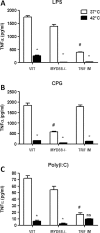The regulation of TNFα production after heat and endotoxin stimulation is dependent on Annexin-A1 and HSP70
- PMID: 25753354
- PMCID: PMC4463914
- DOI: 10.1007/s12192-015-0580-5
The regulation of TNFα production after heat and endotoxin stimulation is dependent on Annexin-A1 and HSP70
Abstract
Febrile temperatures can induce stress responses which protect cells from damage and can reduce inflammation during infections and sepsis. However, the mechanisms behind the protective functions of heat in response to the bacterial endotoxin LPS are unclear. We have recently shown that Annexin-1 (ANXA1)-deficient macrophages exhibited higher TNFα levels after LPS stimulation. Moreover, we have previously reported that ANXA1 can function as a stress protein. Therefore in this study, we determined if ANXA1 is involved in the protective effects of heat on cytokine levels in macrophages after heat and LPS. Exposure of macrophages to 42 °C for 1 h prior to LPS results in an inhibition of TNFα production, which was not evident in ANXA1(-/-) macrophages. We show that this regulation involves primarily MYD88-independent pathways. ANXA1 regulates TNFα mRNA stability after heat and LPS, and this is dependent on endogenous ANXA1 expression and not exogenously secreted factors. Further mechanistic studies revealed the possible involvement of the heat shock protein HSP70 and JNK in the heat and inflammatory stress response regulated by ANXA1. This study shows that ANXA1, an immunomodulatory protein, is critical in the heat stress response induced after heat and endotoxin stimulation.
Figures







Similar articles
-
Differential modulatory effects of annexin 1 on nitric oxide synthase induction by lipopolysaccharide in macrophages.Immunology. 2006 Mar;117(3):340-9. doi: 10.1111/j.1365-2567.2005.02307.x. Immunology. 2006. PMID: 16476053 Free PMC article.
-
The resolution of acute inflammation induced by cyclic AMP is dependent on annexin A1.J Biol Chem. 2017 Aug 18;292(33):13758-13773. doi: 10.1074/jbc.M117.800391. Epub 2017 Jun 27. J Biol Chem. 2017. PMID: 28655761 Free PMC article.
-
The inhibition of LPS-induced production of inflammatory cytokines by HSP70 involves inactivation of the NF-kappaB pathway but not the MAPK pathways.Shock. 2006 Sep;26(3):277-84. doi: 10.1097/01.shk.0000223134.17877.ad. Shock. 2006. PMID: 16912653
-
Endotoxin contamination in recombinant human heat shock protein 70 (Hsp70) preparation is responsible for the induction of tumor necrosis factor alpha release by murine macrophages.J Biol Chem. 2003 Jan 3;278(1):174-9. doi: 10.1074/jbc.M208742200. Epub 2002 Oct 27. J Biol Chem. 2003. PMID: 12403778
-
2-phenylethynesulfonamide Prevents Induction of Pro-inflammatory Factors and Attenuates LPS-induced Liver Injury by Targeting NHE1-Hsp70 Complex in Mice.PLoS One. 2013 Jun 21;8(6):e67582. doi: 10.1371/journal.pone.0067582. Print 2013. PLoS One. 2013. PMID: 23805318 Free PMC article.
Cited by
-
Influence of Moringa oleifera extract, vitamin C, and sodium bicarbonate on heat stress-induced HSP70 expression and cellular immune response in rabbits.Cell Stress Chaperones. 2018 Sep;23(5):975-984. doi: 10.1007/s12192-018-0906-1. Epub 2018 May 4. Cell Stress Chaperones. 2018. PMID: 29728855 Free PMC article.
-
Comparative transcriptome analysis of Glyphodes pyloalis Walker (Lepidoptera: Pyralidae) reveals novel insights into heat stress tolerance in insects.BMC Genomics. 2017 Dec 19;18(1):974. doi: 10.1186/s12864-017-4355-5. BMC Genomics. 2017. PMID: 29258441 Free PMC article.
-
Annexin Animal Models-From Fundamental Principles to Translational Research.Int J Mol Sci. 2021 Mar 26;22(7):3439. doi: 10.3390/ijms22073439. Int J Mol Sci. 2021. PMID: 33810523 Free PMC article. Review.
-
Expression of NaV-1.7, TNF-α and HSP-70 in experimental flare-up post-extirpated dental pulp tissue through a neuroimmunological approach.Saudi Dent J. 2020 May;32(4):206-212. doi: 10.1016/j.sdentj.2019.09.001. Epub 2019 Oct 1. Saudi Dent J. 2020. PMID: 32405224 Free PMC article.
-
The role of annexin A1 in the modulation of the NLRP3 inflammasome.Immunology. 2020 May;160(1):78-89. doi: 10.1111/imm.13184. Epub 2020 Mar 30. Immunology. 2020. PMID: 32107769 Free PMC article.
References
Publication types
MeSH terms
Substances
LinkOut - more resources
Full Text Sources
Other Literature Sources
Research Materials
Miscellaneous

